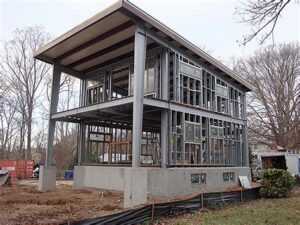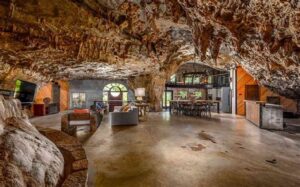Explore the challenges and benefits of hillside construction, design considerations, maximizing views, and ensuring structural stability in sloped terrains.Building a home into a hill presents a unique blend of challenges and opportunities, making hillside construction a fascinating choice for many. As more homeowners seek to embrace the natural beauty of their surroundings, understanding the intricacies of designing houses on sloped sites becomes essential. From navigating the complexities of structural integrity to maximizing breathtaking views and natural light, the path to creating a stunning hillside retreat is filled with creative possibilities. This blog will explore the specific challenges encountered in hillside construction, delve into key design considerations, and highlight the numerous benefits of hillside house plans. We’ll also discuss techniques for ensuring structural stability while celebrating the beauty of a home nestled within a picturesque landscape. Whether you’re contemplating your dream hillside home or simply curious about the process, read on to discover how to make the most of your sloped site.
Challenges of Hillside Construction
Building on a slope presents unique and intriguing challenges that require careful planning and strategic design. One of the prominent challenges is drainage issues. Hillside properties often face water runoff, which can lead to erosion if not properly managed. Engineers must devise solutions such as retaining walls and drainage systems to handle excess water effectively.
Another obstacle is the increased construction costs associated with hillside construction. The complexities of working on sloped terrain often lead to more expensive foundation work, specialized equipment, and extensive site preparation. This contributes to a higher budget than traditional flat site constructions.
Additionally, accessibility problems can arise when building on hillsides. The steep terrain can complicate the delivery of materials and the movement of construction vehicles. Proper planning for access routes and constructio
Design Considerations for Sloped Sites
When embarking on a project involving house plans built into a hill, it is essential to address several design considerations specific to sloped sites. The unique challenges presented by such topography require careful planning and innovative design solutions to ensure both functionality and aesthetic appeal.
One of the primary considerations is the site grading. Proper grading is crucial to manage water drainage effectively, reducing the risk of erosion and retaining wall failures. The placement of the home should also take into account the natural flow of water to prevent costly damage over time. A well-designed drainage system can mitigate many potential issues.
Another key aspect is optimizing for natural light and views. Homes built into hills can take advantage of panoramic vistas while also incorporating large windows and open floor plans to enhance interior lighting. Consider the sun’s path and how it interacts with the terrain to create inviting and energy-efficient spaces inside the home.
| Design Feature | Considerations |
|---|---|
| Site Grading | Ensure effective drainage and erosion control. |
| Window Placement | Maximize views and natural light. |
| Structural Integrity | Incorporate strong foundations to prevent settling. |
| Landscape Design | Utilize terracing to enhance usability of outdoor spaces. |
Ensuring structural integrity is also paramount when constructing on sloped terrains. A solid foundation is necessary to handle the weight of the house and resist shifting soil. Consulting with geotechnical engineers early in the design phase can provide insights on soil stability and necessary reinforcements.
Finally, thoughtful landscape design can significantly enhance the usability of outdoor spaces on sloped lots. Techniques such as terracing can create more level areas for outdoor living, reducing the steepness of
Benefits of Hillside House Plans
Building a home on a hillside presents unique opportunities for both design and living. Hillside house plans can offer distinct advantages that other flat-site constructions simply cannot match. Here, we explore some of the key benefits of opting for a house plan built into a slope.
First and foremost, hillside homes often provide breathtaking views. One of the primary motivations for choosing a sloped site is to maximize panoramic scenery. By positioning the home thoughtfully, homeowners can take full advantage of their natural surroundings. This elevation can lead to an extraordinary connection with nature, allowing one to enjoy the beauty of the landscape right from their living room.
Additionally, natural light is another significant benefit of hillside house designs. When it comes to maximizing daylight, these homes have the advantage of integrating large windows and open spaces that harness sun exposure. Well-placed windows not only enhance the aesthetics of the home but also promote energy efficiency by reducing reliance on artificial lighting during the day.
Moreover, hillside construction often requires innovative design solutions that can result in creative spaces within the home. The natural topography can inspire unique architectural features such as multi-level floors, built-in terraces, or even outdoor living areas that flow seamlessly into the landscape. These designs can enhance the overall experience of living in a home that
Maximizing Views and Natural Light
When designing house plans built into a hill, one of the primary objectives is to maximize views and harness natural light. Hillside locations offer unique perspectives and often panoramic views that can be spectacular when showcased properly.
Architects and builders can employ various design strategies to ensure that homes take full advantage of their hillside position. This may include the use of large windows, open floor plans, and positioning the main living areas on upper levels to capture the best vistas. An essential aspect is the orientation of the house, which should be planned to face the most breathtaking aspects of the landscape.
Incorporating natural light into hillside homes is equally important. Besides large windows, features such as skylights and strategic overhangs can facilitate light penetration while providing shade during the hottest parts of the day. This not only enhances the aesthetic appeal of the home but also reduces relia
Ensuring Structural Stability on Sloped Terrain
When planning house plans built into a hill, ensuring structural stability is of paramount importance. Building on sloped terrain presents unique challenges that require careful consideration and innovative solutions. The right approach not only ensures the safety and durability of the structure but also enhances the aesthetic appeal of the home.
One of the primary factors to consider when constructing on a slope is the foundation design. It is crucial to evaluate the soil type and its load-bearing capacity. A criteria-based approach, which includes soil testing and analysis, helps determine whether a conventional foundation will suffice or if you need a more specialized design, such as a pier and beam or a retaining wall foundation.
Another critical aspect is the drainage system. Proper water management is vital in preventing soil erosion and reducing the risk of landslides. Implementing drainage solutions like French drains, swales, and retaining walls will help redirect water away from the foundation, thereby ensuring the long-term stability of the home. Regular maintenance and monitoring of the drainage systems will further enhance the home’s resilience against natural elements.
Frequently Asked Questions
What are the benefits of building a house into a hill?
Building a house into a hill can offer natural insulation, reduced energy costs, and stunning views while also minimizing environmental impact.
What architectural styles work best for homes built into hills?
Architectural styles such as modern, earth-sheltered, and contemporary designs are often well-suited for hill-integrated homes, emphasizing natural materials and blending with the landscape.
How does building into a hill affect drainage?
Building into a hill can be advantageous for drainage, as the natural slope can facilitate water runoff; however, it’s essential to incorporate proper drainage systems to prevent water pooling.
What considerations should be made regarding construction materials?
When constructing a hill home, consider using materials that are durable and naturally insulating, such as stone, wood, and eco-friendly composites that blend with the local environment.
Are there any zoning regulations for building into a hillside?
Yes, zoning regulations may vary by location, often concerning land stability, water runoff, and environmental impact; it’s crucial to consult local authorities before starting construction.
Can a house built into a hill provide a unique interior layout?
Absolutely! Building into a hill allows for creative interior designs, including split-level floors, open-concept spaces, and greater use of natural light through strategic window placement.
What are some challenges faced when building a house into a hill?
Challenges can include soil stability, excavation needs, increased costs for specialized foundations, and potential for limited access to utilities, requiring careful planning and expertise.





